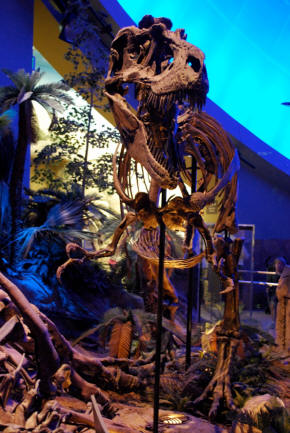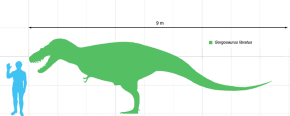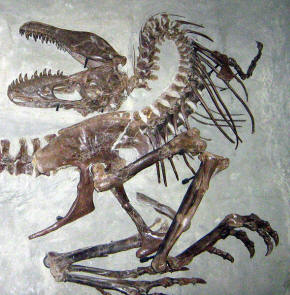|
Gorgosaurus lived in a lush
floodplain environment
along the edge of an
inland sea. An
apex predator, it was
at the top of the food chain, preying
upon abundant
ceratopsids and
hadrosaurs. In some
areas, Gorgosaurus
coexisted with another tyrannosaurid,
Daspletosaurus. Though
these animals were roughly the same size, there is some evidence of
niche differentiation
between the two. Gorgosaurus
is the best-represented tyrannosaurid in the fossil record, known from
dozens of specimens. These plentiful remains have allowed scientists to
investigate its
ontogeny,
life history and other
aspects of its biology.
Description
Gorgosaurus was smaller than
Tyrannosaurus or
Tarbosaurus, closer in
size to Albertosaurus
and Daspletosaurus.
Adults reached 8 or 9 meters (26 to 30 ft) from snout to tail.
Paleontologists have estimated full-grown adults to weigh more than 2.4 tonnes
(2.7 short
tons). The largest known skull measures
99 centimeters (39 in)
long, just slightly smaller than that of
Daspletosaurus. As in other tyrannosaurids, the
skull was large compared to its body size, although chambers within the
skull bones and large openings (fenestrae)
between bones reduced its weight. Albertosaurus
and Gorgosaurus
share proportionally longer and lower skulls than
Daspletosaurus and other
tyrannosaurids. The end of the snout was blunt, and the nasal and parietal bones were
fused along the midline of the skull, as in all other members of the family.
The eye socket was circular
rather than oval or keyhole-shaped as in other tyrannosaurid genera. A tall
crest rose from the lacrimal bone in front
of each eye, similar to
Albertosaurus
and Daspletosaurus.
Differences in the shape of bones surrounding the brain set
Gorgosaurus apart from
Albertosaurus.
Gorgosaurus teeth were typical of all known
tyrannosaurids. The eight
premaxillary teeth at
the front of the snout were smaller than the rest, closely packed and
D-shaped in
cross section. In
Gorgosaurus, the
first tooth in the
maxilla was also shaped
like the premaxillary teeth. The rest of the teeth were oval in cross
section, rather than blade-like as in most other theropods. Along with the
eight premaxillary teeth, Gorgosaurus
had 26 to 30 maxillary teeth and 30 to 34 teeth in the dentary bones of the
lower jaw. This number of teeth is similar to
Albertosaurus and
Daspletosaurus but is fewer than those of
Tarbosaurus or
Tyrannosaurus.
Gorgosaurus shared its general body plan with
all other tyrannosaurids. Its massive head was perched on the end of an
S-shaped neck. In
contrast to its large head, its forelimbs were very small. The forelimbs had
only two digits, although a third metacarpal is known in
some specimens, the
vestigial remains of
the third digit seen in other theropods.
Gorgosaurus had four digits on each hindlimb,
including a small first toe (hallux)
which did not contact the ground. Tyrannosaurid hindlimbs were long relative
to overall body size compared with other theropods. The largest known
Gorgosaurus
femur measured
105 centimeters (41 in) long. In several smaller specimens of
Gorgosaurus, the
tibia was longer than
the femur, a proportion typical of
fast-running animals.
The two bones were of equal length in the largest specimens. The long, heavy
tail served as a counterweight to the
head and torso and placed the center of gravity over
the hips.
Classification and Systematics
Carr et al. 2005
| Tyrannosauridae |
| Albertosaurinae |
|
|
| Tyrannosaurinae |
|
|
|
|
*Note: Carr et al. regard Gorgosaurus
libratus as a species of Albertosaurus and Tarbosaurus
bataar as a species of Tyrannosaurus
Currie et al. 2003
| Tyrannosauridae |
| Albertosaurinae |
|
|
| Tyrannosaurinae |
|
|
|
|
|
Gorgosaurus
is classified in the
theropod subfamily
Albertosaurinae within the family Tyrannosauridae.
It is most closely related to the slightly younger
Albertosaurus. These are
the only two definite albertosaurine genera that have been described,
although other undescribed species may exist.
All other tyrannosaurid genera, including
Daspletosaurus,
Tarbosaurus and
Tyrannosaurus, are classified in the subfamily
Tyrannosaurinae. Compared to the tyrannosaurines, albertosaurines had
slender builds, with proportionately smaller, lower skulls and longer bones
of the lower leg (tibia)
and feet (metatarsals
and phalanges).
The close similarities between
Gorgosaurus libratus
and Albertosaurus sarcophagus
have led many experts to combine them into one genus over the years.
Albertosaurus was named
first, so by convention it is given
priority over the name
Gorgosaurus, which
is sometimes considered its
junior synonym.
William Diller Matthew
and
Barnum Brown doubted
the distinction of the two genera as early as 1922.
Gorgosaurus libratus was
formally reassigned to Albertosaurus
(as Albertosaurus libratus)
by
Dale Russell in 1970,
and many subsequent authors followed his lead. Combining the two greatly
expands the geographical and chronological range of the genus
Albertosaurus. Other
experts maintain the two genera as separate. Canadian paleontologist
Phil Currie claims
there are as many anatomical differences between
Albertosaurus and
Gorgosaurus as there are
between Daspletosaurus
and Tyrannosaurus,
which are almost always kept separate. He also notes that undescribed
tyrannosaurids discovered in Alaska, New Mexico and
elsewhere in North America may help clarify the situation.
Discovery and Naming
Gorgosaurus libratus
was first described by
Lawrence Lambe in 1914. The
type species is
G. libratus. The
holotype of
Gorgosaurus libratus (NMC
2120) is a nearly complete skeleton associated with a skull, discovered in
1913 by
Charles M. Sternberg.
This specimen was the first tyrannosaurid found with a complete hand. It was
found in the
Dinosaur Park Formation
of Alberta and is housed in the
Canadian Museum of Nature
in
Ottawa. Prospectors
from the
American Museum of Natural History
in
New York City were
active along the
Red Deer River in
Alberta at the same time, collecting hundreds of spectacular dinosaur
specimens, including four complete G. libratus
skulls, three of which were associated with skeletons. Matthew and Brown
described four of these specimens in 1923.
Matthew and Brown also described a
fifth skeleton (AMNH
5664), which Charles H.
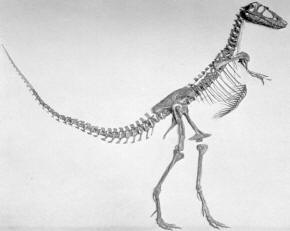 |
| Type
specimen of Gorgosaurus sternbergi (AMNH
5664), now recognized as a juvenile Gorgosaurus libratus |
Sternberg
had collected in 1917 and sold to their museum. It was smaller than other
Gorgosaurus
specimens, with a lower, lighter skull and more elongate limb proportions.
Many
sutures between bones
were unfused in this specimen as well. Matthew and Brown noted that these
features were characteristic of juvenile tyrannosaurids, but still described
it as the holotype of a new species, G.
sternbergi. Today's paleontologists regard this
specimen as a juvenile G. libratus.
Dozens of other specimens have been excavated from the Dinosaur Park
Formation and are housed in museums across the United States and Canada.
G. libratus is the
best-represented tyrannosaurid in the fossil record, known from a virtually
complete growth series.
Several tyrannosaurid skeletons from the
Judith River Formation
of
Montana probably belong
to Gorgosaurus,
although it remains uncertain whether they belong to
G. libratus or a new
species. One specimen from Montana (TCMI
2001.89.1), housed in the
Children's Museum of Indianapolis,
shows evidence of severe
pathologies, including
healed leg, rib, and vertebral
fractures,
osteomyelitis
(infection) at the tip of the lower jaw resulting in permanent tooth loss,
and possibly a
brain tumor.
Paleobiology
Coexistence with Daspletosaurus
In the Dinosaur Park Formation,
Gorgosaurus lived
alongside a rarer species of the tyrannosaurine
Daspletosaurus. This is
one of the few examples of two tyrannosaur genera coexisting. Similar-sized
predators in modern predator
guilds are separated
into different
ecological niches by
anatomical, behavioral or geographical differences that limit competition.
Niche differentiation between the Dinosaur Park tyrannosaurids is not
well-understood. In 1970, Dale Russell hypothesized the more
common
Gorgosaurus
actively hunted fleet-footed
hadrosaurs, while the
rarer and more troublesome
ceratopsians and
ankylosaurians (horned
and heavily armoured dinosaurs)
were left to the more heavy-built
Daspletosaurus.
However, a specimen of Daspletosaurus
(OTM 200) from the contemporaneous
Two Medicine Formation
of Montana preserves the digested remains of a juvenile hadrosaur in its gut
region, and another bonebed contains the remains of three
Daspletosaurus along with
the remains of at least five hadrosaurs.
Unlike some other groups of
dinosaurs, neither genus was more common at higher or lower elevations than
the other. However, Gorgosaurus
appears more common in northern formations like the Dinosaur Park, with
species of Daspletosaurus
more abundant to the south. The same pattern is seen in other groups of
dinosaurs. Chasmosaurine ceratopsians and hadrosaurine hadrosaurs are also
more common in the Two Medicine Formation of Montana and in southwestern
North America during the Campanian, while centrosaurine and lambeosaurines
dominate in northern latitudes. Holtz has suggested this pattern indicates
shared ecological preferences between tyrannosaurines, chasmosaurines and
hadrosaurines. At the end of the later Maastrichtian stage, tyrannosaurines
like Tyrannosaurus rex,
hadrosaurines like
Edmontosaurus and
chasmosaurines like
Triceratops were
widespread throughout western North America, while albertosaurines and
centrosaurines went extinct, and lambeosaurines were rare.
Life History
Gregory Erickson and
colleagues have studied the growth and life history of tyrannosaurids
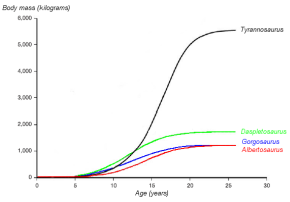 |
| A graph showing the hypothesized growth curves (body mass versus
age) of four tyrannosaurids. Gorgosaurus is shown in blue. |
using
bone
histology, which can
determine the age of a specimen when it died. A growth curve can be
developed when the ages of various individuals are plotted against their
sizes on a graph. Tyrannosaurids grew throughout their lives, but underwent
tremendous growth spurts for about four years, after an extended juvenile
phase.
Sexual maturity may
have ended this rapid growth phase, after which growth slowed down
considerably in adult animals. Examining five
Gorgosaurus specimens of various sizes, Erickson
calculated a maximum growth rate of about 110 kilograms (50 lb) during the
rapid growth phase, slower than in tyrannosaurines like
Daspletosaurus and
Tyrannosaurus, but
comparable to Albertosaurus.
Gorgosaurus
spent as much as half its life in the juvenile phase before ballooning up to
near-maximum size in only a few years. This, along with the complete lack of
predators intermediate in size between huge adult tyrannosaurids and other
small theropods, suggests these niches may have been filled by juvenile
tyrannosaurids. This is seen in modern
Komodo dragons, where
hatchlings start off as tree-dwelling
insectivores and slowly
mature into massive
apex predators capable
of taking down large vertebrates. Other tyrannosaurids, including
Albertosaurus, have been
found in aggregations that some have suggested to represent mixed-age
packs, but there is no
evidence of gregarious behavior in Gorgosaurus.
Paleoecology
All known specimens of
Gorgosaurus libratus have
been recovered from the Dinosaur Park Formation
in Alberta. This formation dates to the middle of the
Campanian, between 76.5
and 74.8 million
years ago. At this time, the area was a
coastal plain along the western edge of the
Western Interior Seaway,
which divided North America in half. The
Laramide Orogeny had
begun uplifting the
Rocky Mountains to the
west, from which flowed great rivers that deposited eroded sediment in vast
floodplains along the
coast. The climate was subtropical with marked
seasonality, and periodic droughts sometimes resulted in massive mortality
among the great herds of dinosaurs, as represented in the numerous bonebed deposits
preserved in the Dinosaur Park Formation. Conifers formed the
forest canopy, while
the understory plants
consisted of ferns, tree ferns and angiosperms. Around
73 million years ago, the seaway began to expand,
transgressing into
areas formerly above sea level and drowning the Dinosaur Park ecosystem.
This transgression, called the Bearpaw Sea, is recorded by the marine
sediments of the massive
Bearpaw Shale.
The Dinosaur Park Formation
preserves a great wealth of vertebrate fossils. A wide variety of fish swam
the rivers and estuaries, including
gars, sturgeons, sharks and rays, among others.
Frogs, salamanders, turtles, crocodilians and
champsosaurs also
dwelled in the aquatic habitats.
Azhdarchid
pterosaurs and
neornithine birds like
Apatornis flew
overhead, while the
enantiornithine bird
Avisaurus lived on the
ground alongside
multituberculate,
marsupial and placental
mammals. A number of
species of terrestrial lizards were also present.
Dinosaur fossils in particular are found with unrivaled abundance and
diversity. Huge herds of
ceratopsids roamed the
floodplains alongside equally large groups of hadrosaurine and lambeosaurine
hadrosaurs. Other
herbivorous groups like
ornithomimids,
therizinosaurs,
pachycephalosaurs,
small
ornithopods,
nodosaurids and
ankylosaurids were also
represented. Small predatory dinosaurs like
oviraptorosaurs,
troodonts and
dromaeosaurs hunted
smaller prey than the huge tyrannosaurids,
Daspletosaurus and
Gorgosaurus, which were two orders of magnitude
larger in mass. Intervening predatory niches may have been filled by young
tyrannosaurids.
Return to the
Old Earth Ministries Online Dinosaur
Curriculum homepage.

Shopping
Bay
State Replicas - No Gorgosaurus replicas
Black
Hills Institute - Full size skull, full skeleton, femer, fibula,
miscellaneous bones.
|
